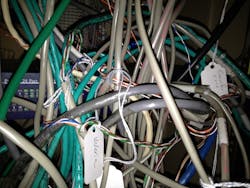The 5 most damaging structured cabling scenarios
The European structured cabling installer Royce Communications has produced a printable PDF technical brief containing a Cause-and-Effect checklist of the 5 most damaging structured cabling scenarios, with short explanations to illustrate "why such problems need to be addressed sooner rather than later."
1. Cause: Intermittent faults - Unidentified intermittent faults are amongst the most common and damaging issues that affect structured cabling networks. Faulty patch leads and broken or malfunctioning outlets are typical causes of this frustrating and puzzling problem, but identifying the lead or outlet that’s misfiring can be a headache in itself.
Effect:Valuable resources are wasted.
2. Cause: Wi-Fi problems - Wi-Fi can present a host of challenges when installed incorrectly - from poor coverage to intermittent connectivity. Connecting multiple devices that use conflicting Wi-Fi standards is a common cause of many problems. Equally, the Wi-Fi devices themselves may be faulty or installed in the wrong position. If neither of these factors are the cause of your issues, check if you’ve connected new Wi-Fi devices with outdated cabling.
Effect: Workforce efficiency and productivity plummet.
3. Cause:Disorganization and disorder - Structured cabling networks often become disorderly over time as multiple firms are called in to install, maintain and repair them, resulting in a confused and jumbled system. A disorganized structured cabling network can also be the result of sloppy workmanship, where engineers haven’t taken enough care during the implementation process. Untidy patching, inaccurate labelling and poor record keeping are all warning signs that shouldn’t be ignored.
Effect: Unnecessary expenditure.
4. Cause: Mismatched cabling - Even if your infrastructure is built on one category of cable, if two different manufacturers have supplied different elements of your network, you may encounter problems. A structured cabling network that isn’t consistent end-to-end can cause electrical mismatching between components and although this can be difficult to spot, the effects are plain to see.
Effect: Costly network challenges.
5. Cause: A lack of network redundancy - Organizations need a backup cabling network and an uninterruptable power supply (UPS) to ensure connectivity and power remain consistent when the lights go out unexpectedly. This is especially true of critical links and services that underpin crucial business operations, for example the structured cabling network that supports a bank’s trading floor. Despite the importance of these systems, we find that many organizations don’t consider installing them until after an incident has taken place.
Effect: A catastrophic loss of service.
Full PDF:Checklist - Is your structured cabling fit for the future?
